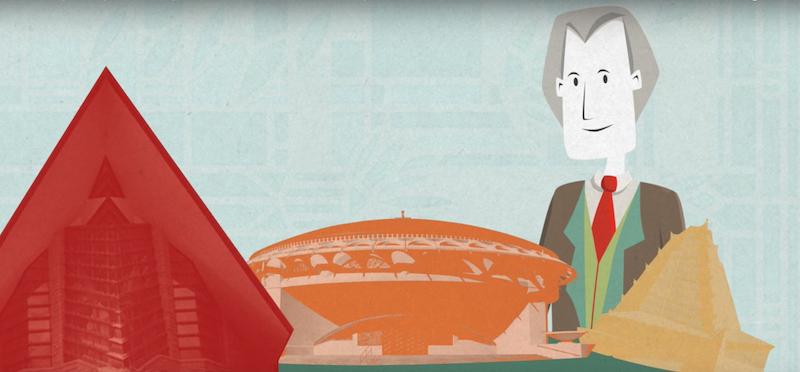Whether you agree with Frank Lloyd Wright’s definition of good architecture or not, the late architect was never anything less than resolute and unswerving in his convictions. If ever you needed evidence of this, look no further than PBS Digital and Quoted Studios’ Blank on Blank animated short featuring excerpts from an interview between Wright and Mike Wallace in 1957.
In the short six-minute video, Wright calls architecture of the past 500 years “phony,” says, if given another 15 years to work, he would rebuild the country and change the nation, and casts aspersions on the New York City skyline calling it a “great monument to money and greed.” Wright certainly doesn’t hold anything back in this interview, but before anyone gets any ideas to call him arrogant, he has a few choice words for you too. “I think any man who really has faith in himself will be dubbed arrogant by his fellows,” Wright says. “I think that’s what happened to me.”
Wright’s interview on The Mike Wallace Show took place when he was 90 years old, just two years before his death. At this point in his life, Wright had designed over 1,000 buildings and had seen over 500 of them come to fruition, but even with so much work under his belt, Father Time was the only thing slowing the 90-year-old architect down and hindering him from accomplishing more.
Returning to his idea of changing the country, Wallace quoted Wright as previously saying, “If I had another 15 years to work, I could rebuild this entire country. I could change the nation.” Wright confirmed that he said this saying, “It’s amazing what I could do for this country. I wouldn’t start to change so much the way we live, as what we live in and how we live in it.”
Wright wasn’t the only architect featured in a Blank on Blank video. A 1965 interview between architect Buckminster Fuller and Studs Terkel was also turned into an episode.
Fuller’s interview isn’t quite as provocative as Wright’s, but he shares some of the same ideas as Wright regarding the current state of architecture. “I saw that the way in which we built was very, very ignorant,” Fuller says.
The rest of the video gives some insight into how and why Fuller developed his architectural style and philosophy.
Both videos act as windows into the minds and imaginations of two architects with very unique and very ambitious ideas for what architecture could and should be.
According to Quoted Studios, its purpose in creating these animated videos from interviews, such as this one featuring Wright and Wallace, is to unlock hidden stories. “Whether they’re interviews sitting on a journalist’s tapes or in a major archive, recordings buried in a media brand’s archives, or the yet to be heard stories within an organization, we transform raw, intimate storytelling into culturally resonant digital content,” the company writes on its website.
Other notable figures featured in the Blank on Blank series include Rod Serling, Ayn Rand, Ray Bradbury, and Carl Sagan.
Related Stories
| Feb 28, 2014
Six finalists selected in design competition for Canadian Holocaust monument
David Adjaye and Daniel Libeskind are among the finalists for the National Holocaust Monument, planned near the Canadian War Museum in Ottawa.
| Feb 27, 2014
Gensler reveals 44 design trends for the next decade
The 82-page report covers dozens of emerging trends in healthcare, commercial office, hospitality, tall buildings, and more.
| Feb 27, 2014
Target converts former prison dump into latest big-box store
Target's new San Rafael, Calif., location was built on the site of the former San Quentin prison dump.
| Feb 27, 2014
Open or private offices? It depends on the business plan
Open layouts are grabbing headlines as a hallmark of the new workplace—think the Google campus or Facebook's headquarters. And for smaller-scale operations, open designs are often lauded for being less expensive than private office plans. But does that mean all offices should have an open layout?
| Feb 27, 2014
3 reasons to apply computational fluid dynamics on your next project
From right-sizing mechanical systems to understanding the impact of design alternatives, CFD offers a host of benefits for the Building Team.
| Feb 27, 2014
12 facts about heat-treated glass: Why stronger isn’t always better
Glass is heat-treated for two reasons: the first is to increase its strength to resist external stresses such as wind and snow loads, or thermal loads caused by the sun’s energy. The second is to temper glass so that it meets safety glazing requirements defined by applicable codes or federal standards.
| Feb 27, 2014
Metal Construction Association introduces two Environmental Product Declarations
Two Environmental Product Declarations (EPD), one for Metal Composite Material Panels and one for Roll Formed Steel Panels for Roofs and Walls, are now available free of charge from the Metal Construction Association (MCA) on its website.
| Feb 27, 2014
Bluebeam Software launches Revu 12 for better field-ready document management and project collaboration
The latest version of the company’s flagship solution better enables users in document-intensive industries to digitally collaborate on project documents and more easily connect the office to the field.
| Feb 27, 2014
PocketCake lunches CPU designed for virtual reality simulations
The company's Virtual Reality Simulation Converter Assembly is three times more powerful than the average high-performance computer and allows for up to eight people to experience a virtual reality simulation at the same time.
| Feb 26, 2014
Adaptive reuse project brings school into historic paper mill
The project features nontraditional classrooms for collaborative learning, an arts and music wing, and a technologically sophisticated global resource center.

















